
Introduction
The concept of tradition has been rooted deeply in various cultures and civilizations for centuries. It holds a significant place in the way people perceive and create things, including art, architecture, and design. Some designers and artists incorporate traditional elements into contemporary designs while others abandon them entirely to create something new. Therefore, defining and understanding the essence of tradition in contemporary design is essential to appreciate its value and impact.
Defining Tradition
Tradition represents a set of beliefs, customs, and practices, which have been passed down from generation to generation. It involves preserving and celebrating the legacy of the past while incorporating critical elements of the present. In contemporary design, tradition can be defined as a combination of historical and cultural references, techniques, and symbols, resulting in an expression of modern ideas through a historical perspective.
The Importance of Tradition in Contemporary Design
Tradition is an essential part of contemporary design in several ways. Firstly, tradition offers a rich source of inspiration and ideas that designers can extract and adapt to fit the modern world. Incorporating traditional elements in contemporary design can create a sense of familiarity, connection, and nostalgia for the past. Secondly, tradition provides a link between the present and the past, ensuring cultural continuity and preserving cultural heritage. Lastly, tradition can be used to unite people across boundaries, as it provides a shared language and experience.
Examples of Tradition in Contemporary Design
There are numerous examples of tradition in contemporary design, ranging from fashion to interior design to product design. For instance, fashion designers often incorporate traditional prints, patterns, and textures in their designs, giving them a modern twist. Traditional techniques such as embroidery, beading, and weaving are likewise found in contemporary clothing. Furthermore, product designers are adopting traditional materials such as wood, leather, and clay, to construct modern products with a historical context. Lastly, many interior designers use traditional design elements such as ornate carvings, textured wall treatments, and decorative moldings, to create an atmosphere that feels timeless yet contemporary.
The Future of Tradition in Contemporary Design
The role of tradition in contemporary design is likely to continue in the future. As society progresses, designers are exploring new ways to incorporate traditional elements into their creations, resulting in a fusion of old and new elements. Furthermore, globalisation has made the world more connected, allowing people to exchange cultural ideas and products. However, it is essential to ensure that the designers and artists respect the cultural heritage and produce designs that are ethical, sustainable, and respectful of the traditions from which they draw inspiration.





